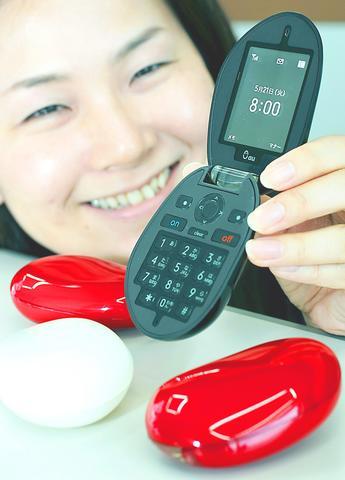Leather, pebbles, fish ... not quite what comes to mind when you think of mobile phones.
Japan's operators, however, believe they can ring up quite a few more customers by using those ideas to tap into the country's keen sense of fashion and offer phones that look -- and feel -- cool.
KDDI Corp's candy bar-shaped mobile phone with a keypad reminiscent of shiny bathroom tiles could be a supermodel's accessory item in a fashion show.

PHOTO: REUTERS
A phone with a changeable leather exterior by Vodafone Holdings KK looks like a chic compact wallet while NTT DoCoMo Inc's tiny aluminum phone would look completely at home in the palm of James Bond's hand.
After years of relying on the latest high-tech features to lure consumers into replacing their old phones, Japanese mobile operators are going back to the basics and looking at design.
"Phones generally look very similar in Japan," said Yoshihiro Uramoto, manager in Vodafone's product management department.
"They fold in half like a clamshell and are generic in design. That captures the mass market, but that's no longer enough ... my perception is that consumers are unhappy with existing phone designs."
Japanese operators and manufacturers are only now latching onto a strategy that has always been a key element for European and US makers.
Nokia, the world's largest mobile handset maker, launched its lightweight 8210 phone in 1999 at a fashion show in Paris. Motorola Inc provided one of its latest phones to acting and directing nominees at this year's Academy Awards.
"Overseas markets have always had more variety because that's what they used to differentiate themselves," said Nahoko Mitsuyama, a Tokyo-based telecoms analyst with Gartner Japan.
Not so in Japan where now essential features such as integrated cameras and high-quality screens large enough to easily surf the mobile Internet have turned phones into dull, metallic or plastic clones of each other.
A dearth of new compelling features and services have also kept consumers away from stores. The latest industry data showed April mobile phone shipments dropped nearly 20 percent from a year ago.
Kazuyo Katsuma, a telecoms analyst with JP Morgan, says operators are turning to design as a way to differentiate themselves, especially as services and features become increasingly alike.
One design hit can have a lasting positive impact, as KDDI's main mobile phone unit "au" discovered late last year.
Instead of giving handset makers the customary discretion, the number two mobile operator took design into its own hands, creating a special project team that hired internationally renowned industrial designers like Japan's Naoto Fukasawa and Australia's Marc Newson.
The first of these phones was a slim candy bar-shaped phone with shiny red, white, and blue tile-like keypads that evoked the image of a colorful carp. It was initially priced at ?16,800 (US$154), cheaper than the company's most advanced models.
The phone, known as the INFOBAR, strengthened au's brand image almost overnight as proud owners showed off their phones by hanging them on a strap around their necks. Au itself became identified as a cutting-edge company with stylish phones.
"Modern Japan has been known for its high-tech gadgets, but we should combine high-tech with a high fashion sense," said Satoshi Sunahara, assistant manager in au's marketing strategy department.
"We wanted to create a product that customers were excited to hold."

The canonical shot of an East Asian city is a night skyline studded with towering apartment and office buildings, bright with neon and plastic signage, a landscape of energy and modernity. Another classic image is the same city seen from above, in which identical apartment towers march across the city, spilling out over nearby geography, like stylized soldiers colonizing new territory in a board game. Densely populated dynamic conurbations of money, technological innovation and convenience, it is hard to see the cities of East Asia as what they truly are: necropolises. Why is this? The East Asian development model, with

June 16 to June 22 The following flyer appeared on the streets of Hsinchu on June 12, 1895: “Taipei has already fallen to the Japanese barbarians, who have brought great misery to our land and people. We heard that the Japanese occupiers will tax our gardens, our houses, our bodies, and even our chickens, dogs, cows and pigs. They wear their hair wild, carve their teeth, tattoo their foreheads, wear strange clothes and speak a strange language. How can we be ruled by such people?” Posted by civilian militia leader Wu Tang-hsing (吳湯興), it was a call to arms to retake

Desperate dads meet in car parks to exchange packets; exhausted parents slip it into their kids’ drinks; families wait months for prescriptions buy it “off label.” But is it worth the risk? “The first time I gave him a gummy, I thought, ‘Oh my God, have I killed him?’ He just passed out in front of the TV. That never happens.” Jen remembers giving her son, David, six, melatonin to help him sleep. She got them from a friend, a pediatrician who gave them to her own child. “It was sort of hilarious. She had half a tub of gummies,

The wide-screen spectacle of Formula One gets a gleaming, rip-roaring workout in Joseph Kosinski’s F1, a fine-tuned machine of a movie that, in its most riveting racing scenes, approaches a kind of high-speed splendor. Kosinski, who last endeavored to put moviegoers in the seat of a fighter jet in Top Gun: Maverick, has moved to the open cockpits of Formula One with much the same affection, if not outright need, for speed. A lot of the same team is back. Jerry Bruckheimer produces. Ehren Kruger, a co-writer on Maverick, takes sole credit here. Hans Zimmer, a co-composer previously, supplies the thumping